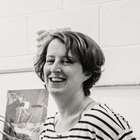Sonic Kayak open hacklab 1
Posted March 17, 2016 by Amber GriffithsThis week we welcomed sound artist Kaffe Matthews and marine researcher Dr. Kirsty Kemp to FoAM Kernow to begin our exploration into Sonic Kayaks, as part of an open hacklab.
The Sonic Kayak project has evolved from the Bicrophonic Research Institute (BRI), established by Kaffe Matthews and David Griffiths in 2014. Through ten years of international projects the BRI has developed the Sonic Bike whose music changes depending on where and how fast the cyclist goes, played through a pair of bike-mounted speakers and onboard GPS system. Our plan now is to evolve the Sonic Bikes to the coastal marinescape.
The Sonic Kayak will be a musical instrument with which to investigate nature. Kayaks rigged with underwater environmental sensors will generate live music from the marine world, providing the paddler with an extra dimension of senses with which to explore the underwater climate, while enabling citizens to gather important climate/environmental data.
We launched an open invitation for interested collaborators to join our hacklab event to begin to design and prototype the system - growing a collective practice.
We were bound by the tides – after an introduction to the Sonic Bikes project we took to the water to see how the existing Sonic Bike system fared on the kayaks, with rudimentary waterproofing. Pre-defined samples played in different spatial zones, prompting feedback including feeling 'traumatised' by the juxtaposition of the sound and the environment. Listening to the underwater sounds through hydrophones brought the calm that we all became keen to embed in the Sonic Kayaks – the overwhelming positivity for these sounds means hydrophones will certainly form part of the sonification apparatus.
Preparing the first tests of the Sonic Bike system on a kayak and Kaffe listening to swans' feet with the hydrophone.
We spent time thinking about how best to use the sensor data to create an additional layer of sound, or to modify the hydrophone sounds – given our aims we decided it was important to have a direct simple translation of the data – for example as the temperature rises so does the pitch.
The ability to turn off the sound turned out to be important – to allow the paddler to experience the surroundings without the additional layer of information. We talked about having a simple switch to turn the sound off, creating quiet zones that the paddler could move into, or fading the sound out when the boat stopped moving.
Other modes of controlling sound were considered for future versions - could the paddle action, speed and direction provide direct control of the sound, could the kayaks interact providing a game play element.
Sonic Bike speakers being rigged on a kayak and two proto-sonic-kayaks on the water.
Together we discussed the data that would be most useful for scientific research – temperature is the obvious target and also most straightforward to collect. Turbidity came up as a new idea, particularly for monitoring farming run-off or the impacts of dredging – and someone has already published plans for an open-source turbidity sensor. Another potentially interesting application is simply for producing fine-scale maps of marine noise.
We trailed a loaned expensive temperature logger from the back of the kayaks to get an idea of the sea-surface temperature variation – which was about one degree Celsius in the ~100m squared area that we covered. This is enough to produce variation in sound over space. We bought some cheap waterproof temperature sensors and managed to get them rigged up to the Raspberry Pi – using Pure Data we generated a sound from the thermistor data, with tests using cups of different temperature water to play simple sounds. This is a great proof-of-concept for the Sonic Kayaks system.
Pricey temperature sensor for mapping the estuarine climate and Chris warming the cheap temperature sensor to generate pitch changes.
The existing Sonic Bike system involves a map to create zones of sounds that are played as the GPS-enabled bikes are peddled into certain areas. For the Sonic Kayaks the map will likely provide a different purpose – perhaps an online map of sensor data collected showing where the gaps are to allow people to actively seek out areas that have not yet been sampled, or to define special 'protected' areas in space where different instructions create unique soundscapes.
More pictures of the event and prototypes can be found here.
You can find the Sonic Kayaks at the British Science Festival (Swansea, 6-9 September 2016).
This project is funded by FEAST Cornwall and the British Science Association.
Created: 15 Jul 2021 / Updated: 15 Jul 2021



